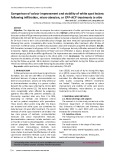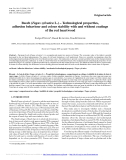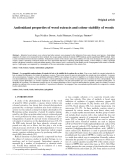
152
Journal of Medicine and Pharmacy, Volume 12, No.07/2022
Comparison of colour improvement and stability of white spot lesions
following infiltration, micro-abrasion, or CPP-ACP treatments in vitro
Phan Anh Chi1*, Le Thi Nhat Linh1, Dang Khac An1
(1) Faculty of Ondonto -Stomatology, University of Medicine and Pharmarcy, Hue University
Abstract
Objective: The objective was to compare the colour improvement of white spot lesion and the colour
stability of treated enamel to after discolouration in vitro. Method: Artificial WSLs (2*2 mm) were created on
the outer surface of 60 permanent premolars and randomly allocated to 4 groups. Specimens were treated with
infiltration (RI), CPP-ACP (CPP), and micro-abrasion (MA) or remained untreated (UT).Groups were discoloured
for 24 hours in tea or tea + citric acidVisible colour changes (ΔE) were measured spectrophotometrically on
following time points: immediately after lesion formation, immediately after treatment, after 30 days of
immersion in artificial saliva, anh aftere discolouration. Data were analyzed using SPSS 20 software. Results:
WSL formation increased in all groups. ΔE1 is creater 3.7 in all groups but only infiltration reduced this effect
to baseline. Highest ΔE4was obtained by CPP-ACP and resin infiltration is lowest. Between the RI and MA
treatment groups, ΔE4 did not differ significantly. The improvement was more stable for infiltration and micro
abrasion during discolouratio compare to the others (ΔE4 < 3.7). Conclusions: The method of infiltration
improves the aesthetics of white spot lesions immediately after treatment and maintains treatment results
during the follow-up period. Micro abrasion improved white spot aesthetics during the follow-up period.
These two methods WSLs were stable following discolouration challenge.
Key words: white spot lesion, infiltration, micro abrasion, CPP-ACP
1. INTRODUCTION
White spot lesions are not only early sign of caries
formation, but also are side-effect of orthodontic
treatment because of plaque accommodation on
teeth or around braces. Lesions are milky white due
to demineralization resulting in a porous surface
beneath the surface layer, altering the normal light
reflectivity of the enamel [1]. This lesion becomes
more recognizable when affected by exogenous
pigments that affect the patient’s aesthetics [2].
Occurently, reported rates vary from 2 to 96%,
depending on methods and detection criteria
as well as patient compliance with precautions.
These lesions often persist long after the braces
are removed and white spots can sometimes be
detected even 12 years after treatment. The recent
methods of white spots treatment are divided into
two main groups of methods: remineralization
measures and colour improvement measures.
Remineralization measures include methods such
as Fluoride or Casein phosphopeptide - Amorphous
calcium phosphate. Other methods to improve
color include micro-abrasive methods, resin
penetration or bleaching [3]. Currently, there are
some studies to evaluate the effectiveness of white
spot lesions treatment methods such as the study
of Yetkiner et al (2014), the study of Dam Minh
Tuan (2016), the study of by Vo Truong Nhu Ngoc
et al (2017), research by Yadav et al (2019) [2], [4],
[5], [6]. However, most of these studies have only
evaluated the effectiveness of a single method,
while studies comparing different treatments
are limited. Therefore, we compared to colour
improvement and stability of white spot lesions
following infiltration, micro-abrasion, or cpp-acp
treatments in vitro in our study.
2. MATERIALS AND METHODS
2.1. Research design and subjects
The research is in vitro study, carried out at the
Preclinical Department of Odonto-Stomatology,
Hue University of Medicine and Pharmacy from
September 2021 to April 2022 with pre-molars
extracted for orthodontic reasons.
2.2. Selection criteria
The following selection criteria were used in
the research:
Inclusion criteria
The tooth remains in the shape of the crown.
Exclusion criteria
- Teeth had caries, enamel hypoplasia, cracks, worn
teeth.
- Teeth infected with Fluoride, Tetracycline,
teeth with enamel hypoplasia.
Corresponding author: Phan Anh Chi, email: pachi@huemed-univ.edu.vn
Recieved: 5/11/2022; Accepted: 1/12/2022; Published: 30/12/2022
DOI: 10.34071/jmp.2022.7.21























